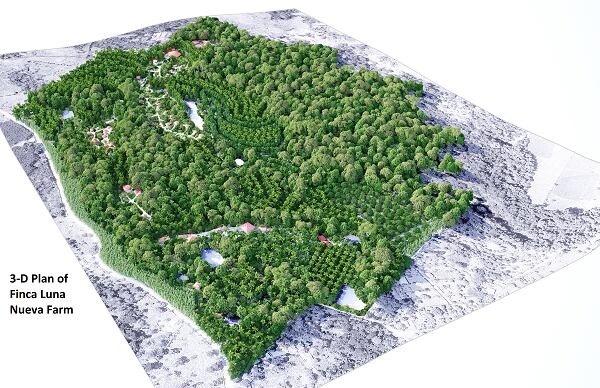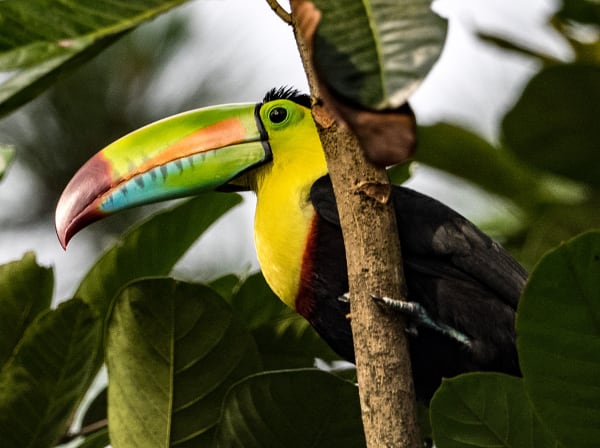And who better to explain about it than the founders of one of the most progressive and forward thinking regenerative farming projects, Familia Luna Farms, located in Alajuela Province, Costa Rica.
In the second of a series of three articles, we go beyond the vision the founders have set out for their own botanical farming project, Finca Luna Nueva, to find out about how naturally enhanced soil can help generate pesticide-free botanical crops that have higher nutritional and active properties.
Soil health always comes first
Key regenerative agriculture phrases
Soil food web – the community of organisms living in the soil
Soil glues and gums – control dust and erosion and protects erosion
Microaggregates – a microscropic collection of soil compounds
Synthetic model – based on synthetic fertilizers and pesticides
Swidden agriculture – a form of rotational farming
Permaculture – development of sustainable, self-sufficient ecosystems
In the video accompanying this article, founder Tom Newmark explains in some detail about how regenerative farming principles put soil health first, with the goal of creating more efficient and higher quality crops.
“We have it backwards in our thinking. We believe that soil creates plants, but actually plants are the creators of this universe and you can see it on the root tips of healthy plants. The fuller roots help create the soil,” Tom said.
Going into more detail, Tom explains how the main goal is to draw potentially dangerous levels of carbon from the atmosphere, then reconvert it into carbohydrates that pass through the plant roots via the food soil web to provide enhanced nutrition for the plant.
In a complex process, the glues and gums created by the activity of the soil food web essentially give way to the ‘mortar’ for microaggregates that harbor a nitrogen fixing bacteria crucial to supporting healthy plant life.
How conventional farming neglects soil health
Speaking off-camera, Tom went on to explain about how regenerative practices are implemented at the farm and the difference it has made to the quality of the soils, ultimately providing the right conditions for a wide variety of plants to thrive.
“In a synthetic model the plant does not need the microbial community to be so healthy because it is reliant on synthetic fertility, so the plant is not encouraged or incentivized to share its plant sugars and carbs with the soil food web and the plant doesn’t have the benefit of the outsourcing of nutrients in the soil,” Tom said.
“There is scientific research that shows plants grown in the right regenerative system, with the right microorganisms and cover plants, will have a greater nutrient density, compared to the same plants grown in the conventional model.”
How the soil on the farm was enhanced

Over a period of more than two decades, the simple but highly effective practices at the farm have helped create a rotational farming system that promotes biodiversity, while increasing the fertility of the soil, negating the need for chemical pesticides and enhancing plant quality.
“We are seeing a renewed vigor thanks to these practices,” Stephen Farrell, project founder, also said off-camera.
“Over the last 20 years we have allowed the diversity to return to the farm, and using Swidden type agriculture, we are able to let it regenerate into a forest, then we cut back that material and let it lay on the ground so it breaks down, providing food for the microorganisms that is then delivered back into the crops that we later plant.”
From supplements to multi-crop farming
As Tom points out, the history of the farm is tied to his connections with the supplements industry, which is why the production has historically focused on crops such as organic turmeric and ginger, but as the farm has evolved the scope and vision for the project has developed in tandem to expand into new areas for botanicals, including the cosmetics and personal care industry.
The Finca Luna Nueva farm forms the anchor to the the Familia Luna Nueva project, which currently incorporates three other farms in the same area – Brave Earth, Esplendor de la Luna and La La Luna.
Combined, the resources of the four farms are being developed through a three phase 30 year that aims to profitably farm a wide selection of crops that will include cacao, botanical extracts for essential oils and supplements, aquaculture, dairy, bamboo and livestock.
But ultimately, the team believes that, by enhancing the quality of the soil, the properties of the botanical crops will be enhanced, and clear evidence of this has already been documented.
“Scientists studying the nutrient profile of our ginger and turmeric have said that they have never seen a phytochemical richness and activity like they have seen in our turmeric and ginger Soil heath is pivotal,” said Tom.
**Watch out for Parts I and III in this series. Published yesterday and tomorrow, Part I looks at the vision for regenerative farming and the advantages for botanical crops, while Part III will focus on how the practice translates into high grade botanical extracts with enhanced properties.**

